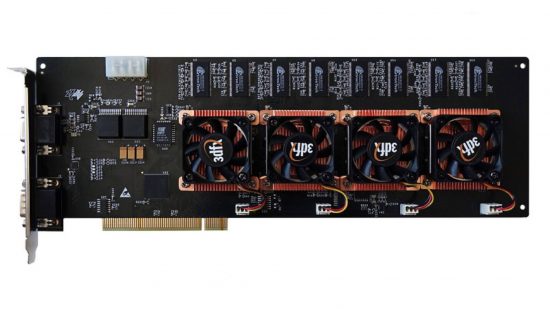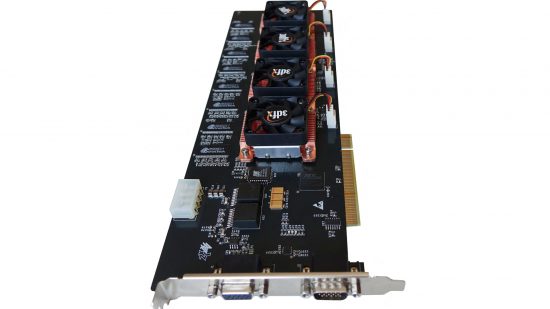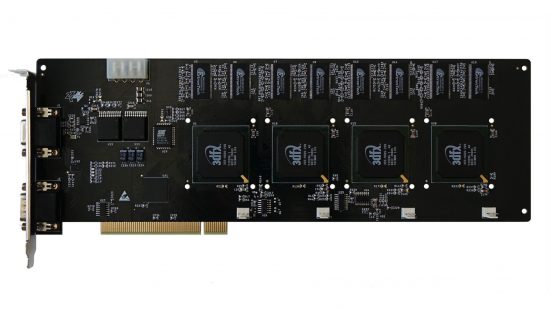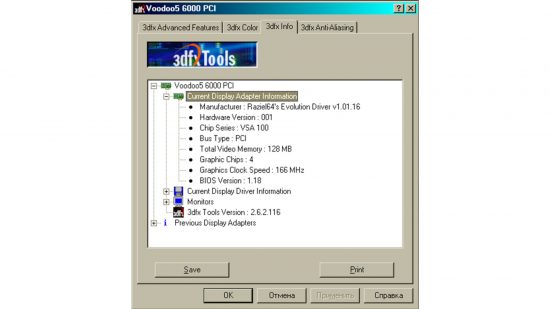With huge PCBs, external power bricks, up to 128MB of memory and a new chip codenamed Napalm, the 3dfx Voodoo 4 and 3dfx Voodoo 5 cards looked set to race past the competition in a fiery blaze, trample on the Nvidia GeForce 256 and reinstate 3dfx at the top of the 3D graphics scene.
It was 2000, and until recently, 3dfx had been the brand of the moment in 3D acceleration, but Nvidia’s TNT2 and later GeForce 256 were making a bit of a mockery of 3dfx’s Voodoo 3, which could only display games in 16-bit color, rather than 32-bit.
3dfx had some new ideas to retake its throne, but it was beset by delays. The one idea that made it to production, several months after the GeForce 256, was the VSA-100 chip, codenamed Napalm.
It could display 3D games in full 32-bit color and it also introduced us to anti-aliasing, with a performance-killing (but very good-looking) option in the driver that used super-sampling. What’s more, 3dfx could use its SLI (scan line interleave) technology to chain multiple VSA-100 chips together on one PCB.
The adverts in magazines looked great – the product stack started at the Voodoo 4 4500, which had one VSA-100 chip, with the Voodoo 5 5000 and 5500 having two VSA-100 chips and 32MB and 64MB of memory respectively (half of which would be shared with each chip). The Voodoo 5 5000 never made it to production, though, and the same also goes for a mysterious top-end card that was also featured in the ads – the Voodoo 5 6000.
This mighty card was so powerful, it needed an external power supply, and it had four VSA-100 chips on its massive circuitboard, each with 32MB of memory for a total of 128MB – huge at the time. There was no hardware transform and lighting, unlike the Nvidia GeForce and ATI Radeon, but 3dfx hoped it could make up for this with the sheer brute force of four graphics chips. It was a bit like a Dick Dastardly Wacky Races contraption, and while a few sample cards were produced, it never made it to the shops.
Since then, the Voodoo 5 6000 has been the Holy Grail of 3dfx fans, but they’re extraordinarily hard to find, which gave Russian electronics hobbyist Anthony Zxclxiv an idea – could he recreate one from scratch? After all, you can still buy VSA-100 chips on eBay, and he’d already experimented with recreating some other 3dfx cards.
Voodoo magic
To start, he needed an original Voodoo 5 6000 card. ‘A major hardware collector helped me,’ says Anthony. ‘His handle is Hard1k online.’ He then needed to recreate the PCB as best possible, which is where Anthony’s knowledge from his previous projects came in handy.
‘I’m a hobbyist, but I have plenty of available time,’ he says. ‘Without my background in a variety of other projects, this one would be impossible for sure. Making the PCB wasn’t very complicated – I placed all the design blocks around the board and solved the puzzle that way – there were no other available variations.
‘Moreover, I’d already made a couple of working VSA-100 projects before, so this one wasn’t a big deal. The BIOS is an original one, as are the drivers, so there was no need for me to tweak or modify these parts.’
Anthony’s new card isn’t just a straightforward copy though. ‘It differs in some minor ways, I believe,’ he says. ‘I didn’t see the original PCB, besides the top layers, so I can’t give an exact answer. The power unit is completely different, of course.’ It is indeed – while the original Voodoo 5 6000 needed an external power brick, Anthony’s card can get all its power from a single Molex connector.
‘Each pin of this connector is able to pass 8A,’ he explains, ‘and this card requires 5A on a 12V line – all the rest depends on the quality of your power supply and power wiring.’ It may well be that the original Voodoo 5 6000 didn’t technically need an external PSU, but that 3dfx erred on the side of caution given the general poor quality (and the lack of high-current 12V rails) of PC power supplies at this time.
The cooling setup is different too. ‘I can’t afford to produce a custom cooling system,’ Anthony says, ‘but this one is quite good and expensive. It uses heavy-duty server coolers powered from 5V instead of 12V – it all cost around $100. Also, the fans are durable ones with two ball bearings – you can’t compare them with the original sleeve-bearing crap.’
The end result is a really cool-looking card that measures 311 x 110mm – Anthony is currently calling it the Napalm 6000 SUX (Special Unified Xcelerator). His card uses the PCI interface (the Voodoo 4 and Voodoo 5 cards came in both PCI and AGP versions), but Anthony says he’s considering making an AGP version too. ‘Modifications for AGP depend on the signaling level being 3.3V or 1.5V,’ he says. ‘The latter requires a lot of testing and work.’
Could he go one step further and even add a digital output, such as HDMI, to replace the analog VGA output? ‘Nope,’ he says. ‘It’s not possible without complex FPGA development. Even if it was possible, there’s no place to make a fan-out for digital RGB signals.’ There are two VGA connectors on the backplate, though, a bit like the original Voodoo and Voodoo 2 cards. The male one is a ‘VGA-in for another video card,’ explains Anthony, ‘if anyone has the intention of using one along with this card.’
Can we buy one please?
The card all seems to work fine with both original 3dfx drivers and third-party drivers, and Anthony even says his card has some of the same quirks of the original 3dfx card. ‘There is noticeable SLI banding in certain graphic modes,’ he says – referring to the banding effect created by multiple chips working alternately on different scan lines on the screen. ‘It’s not as much as on the original card, but it exists.’
We ask him if he has any plans to release the schematics for his card to the community, or the Gerber files – an ASCII vector format used for PCB design. ‘I have no plans to publish the Gerbers,’ he says. ‘However, I’m considering publishing all the 3dfx schematics I made by myself in the form of a small book or big booklet.’ He warns that ‘it takes a lot of work to make a board from a schematic, though, and the PCB for this board is beyond basic level – JLCPCB (a large PCB manufacturer in China) doesn’t have the ability to produce it, so the production cost is quite high’.
If making your own card isn’t a goer, could you maybe buy one ready-made? ‘Yes, they will be available in a limited quantity,’ says Anthony. ‘The estimated price is $1,500.’ If you’re a 3dfx fan with cash to spare, you could soon buy a working 3dfx Voodoo 5 6000 card without having to track down an original sample. You can see more details about Anthony Zxclxiv’s hardware projects on his Facebook page.
Bringing us back to the present day, if you’re looking to upgrade to the latest Nvidia or AMD GPU, make sure you read our full guide to the best graphics card, which covers the best options at a range of prices. One of our current favorites from the firm that ended up buying out 3dfx is the Nvidia GeForce RTX 4070.
For more articles about the PC’s vintage history, check out our Retro tech page, and if you love a bit of 3dfx nostalgia, have a read of our full features on the 3dfx Voodoo2 and the original 3dfx Voodoo 3D cards.



